Best day trips from Florence (without a car)
Florence is located in the heart of Tuscany, in the middle of central Italy. It is a strategic position that allows you to quickly reach many other interesting places in Italy. After visiting the city of Florence, you can spend one or more days to discover villages nestled in the rolling hills, towns rich in history and art, little-known and off the beaten path places. In this post you will find a list of the best day trips you can do from Florence, even without driving a car, with all the information you need: how to get there, how long it takes and what to do and see.
At the end of this post you will find a map where I have pointed all the places I’ve mentioned.
My name is Claudia, I’m local licensed tour guide in Florence with more than 10 years of experience. Learn more about me and my guided tours in Florence!
Tuscany, day and half-day trips from Florence by train or bus
Here you will find all the day trips from Florence that you can do. Medium and large towns are easily reached by train, while small villages are often off the railway lines, and the only way to reach them without having to drive a car is with an organized tour including transport.
Some destinations are very close and small enough to be visited in a few hours, so you can also do a half day trip, in case you don’t have much time.
In case you want to rent a car to move around freely, I recommend you to use Booking.com to compare the prices of the main car rental companies and find the best deal. Click below to find all my tips on…
Day trip from Florence to Chianti, Tuscany (wine tasting)
Chianti is a country region of Tuscany, that stretches between the cities of Florence and Siena, famous throughout the world for its landscape (the famous rolling hills of Tuscany) and for its excellent wines. A day in Chianti to discover vineyards, ancient castles and charming villages is one of the experiences not to be missed during a trip to Florence and Tuscany.
Chianti is divided into two sub-regions, Chianti Fiorentino and Chianti Senese. The most popular villages among tourists are located in the Chianti Senese area (the one closer to Siena). they are Castellina in Chianti, Radda in Chianti and Gaiole in Chianti. But also the Florentine side, Chianti Fiorentino, has some lovely villages and tons of wine culture. Some of my favorite places in Chianti Fiorentino are:
- The whole area of Tavarnelle Val di Pesa, still very authentic and undiscovered compared to other parts of Chianti.
- The whole area of San Casciano Val di Pesa, especially the village of Panzano.
- The countryside between Pontassieve and Rufina, with a perfect mix of vineyards and forests. Rufina is actually the birthplace of some of the best Chianti wines.
- The village of Impruneta, with its beautiful Sanctuary of Madonna dell’Impruneta, and the millenary tradition of terracotta making.
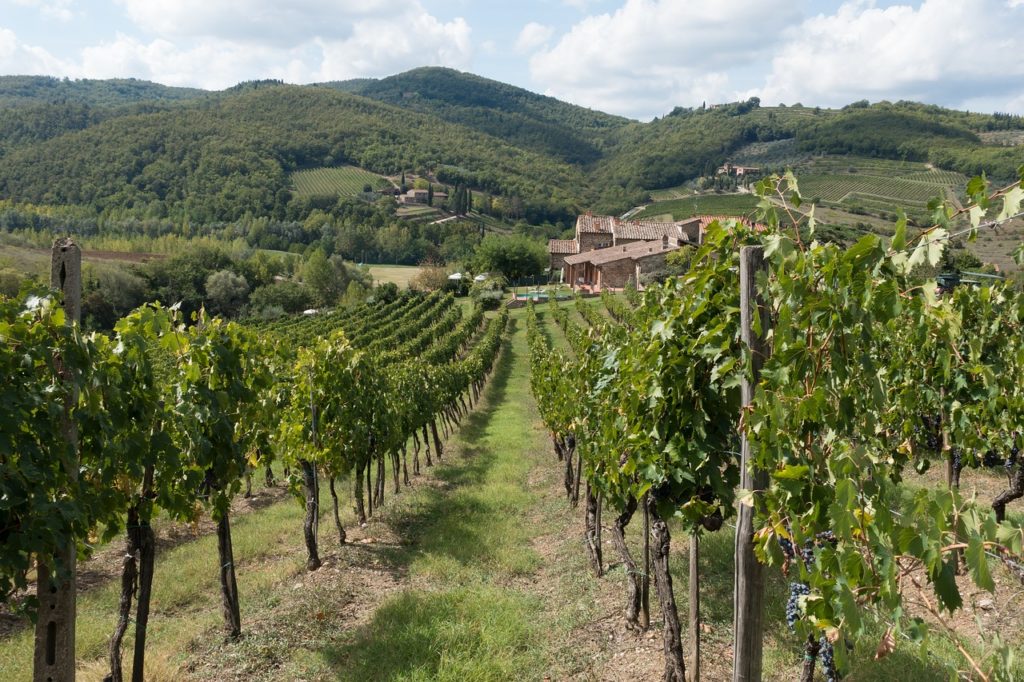
If you want to visit Chianti independently, the only option is a rental car: the most beautiful villages and vineyards for wine tasting are scattered in the countryside and cannot be reached by train or bus. And driving around on secondary roads gives you the chance to see all the most beautiful country landscapes. The simplest solution for those who don’t want to drive is to book an organized guided day trip that includes transport. Guided tours usually include lunch, a visit to a vineyard, and one or more wine tasting experiences. In my opinion it is the best way to see and do as many things as possible in one day in Chianti. Here are some ideas:
- Chianti wine tour and San Gimignano with lunch
- Wine tasting experience in Chianti (with olive oil tasting and local food)
- Vespa tour in Chianti with lunch
Fiesole
Fiesole is one of the easiest day trips from Florence that you can plan entirely on your own. It’s very close to the city (less than 10 kms), and you don’t need a car to get there, there is a bus, line n. 7, which leaves from Piazza della Libertà and arrives in Fiesole in about 20 minutes.
Fiesole is a very ancient city, much older than Florence. It was founded by the Etruscans around the 4th century BC, and was an important Etruscan city until 63 BC, when it was conquered by the Romans. Both civilizations left a mark that is still clearly visible: an archaeological area full of Etruscan and Roman ruins, and above all the massive and ancient Etruscan walls, some parts of which still survive today.
What to see and do in Fiesole:
- Start your visit from the main square, Piazza Mino da Fiesole, which overlooks the Duomo di Fiesole.
- Then continue with a visit to the archaeological area, where the ruins of some important ancient Roman buildings stand: the baths, the temple and the theatre (which is still used today). A rich archaeological museum displays all the many objects found in the area.
- My absolute favorite place in Fiesole is the convent of San Francesco, which is located on the top of the highest hill, behind the village, where the Etruscan necropolis once was. To get there take a short but very steep road (via San Francesco), but I swear that the view is worth the effort. The 14th century convent is an oasis of peace where the Franciscan friars still live today. Inside there is a small but curious museum with objects from all over the world, collected by the missionary friars, including Egyptian cat mummies.
- You can enjoy the view of the whole city of Florence from above from the viewpoint next to Villa San Michele hotel, it’s a 10 minute walk from piazza Mino da Fiesole (it’s pointed on google maps).
- For Renaissance painting lovers, don’t miss the convent of San Domenico (also still inhabited by Dominican friars), which houses some masterpieces by Beato Angelico.
Siena, best day and half-day trip from Florence
Siena is a beautiful city, rich in art, history and magnificent monuments, such as its gothic cathedral. For centuries a rival of Florence, Siena has a strong local identity and ancient traditions such as the Palio di Siena, a horse race in the narrow medieval streets of the city. Siena is small and its historic center can be explored entirely on foot, but there are so many places to see, churches and museums to visit that one day is just enough. Some of the unmissable things to see in Siena:
- Piazza del Campo. Siena’s main piazza is a medieval gem of architecture, with its unique seashell shape, the Palazzo Pubblico and its iconic tower Torre Del Mangia (you can climb it for a sunning view of the piazza and the city).
- The Cathedral of Siena: built in the 13th century, it’s one of the most impressive gothic cathedrals in Italy, with tons of artworks, and the most stunning marble mosaic floor ever (uncovered only twice a year).
- Il Facciatone, aka the big facade. In the 14th century, Siena decided to expand its cathedral to rival the Duomo in Florence. In 1339, construction began on a new facade for a new, immense cathedral, so large that the existing one would become the transept of the new one. After a few years, however, the project was abandoned due to the plague and the subsequent economic crisis. The Facciatone is what is left of that huge project, and you can climb on it to enjoy another stunning view of Siena. To climb the Facciatone, visit the Museo dell’Opera del Duomo: it’s at the end of the visiting path.
- For architecture and art lovers, the church of Santa Maria della Scala and the Basilica di San Domenico, two masterpieces of Tuscan gothic architecture.
Siena is about an hour’s drive from Florence, or an hour and a half by train. The regional trains from Florence Santa Maria Novella to Siena FS are frequent (one every 30 minutes) but often crowded and late. If you get to Siena on your own, I recommend you to take a guided tour of the city to optimize your time there:
Also in this case you can choose to take an guided tour of Siena, including transport to and from Florence, and perhaps also including some other activities, such as a visit to a countryside village or a wine tasting experience. Here are some ideas:
- Siena, San Gimignano and Pisa day trip with lunch at a winery
- Siena and San Gimignano small group tour with lunch

San Gimignano
San Gimignano is a medieval village famous for its ancient towers, built in the 1200s by local families to show off their wealth and power. Once there were 72 towers, today 13 remain. Most of these are private property, and therefore cannot be visited, but you can climb the top of the Torre Grossa, in the Palazzo Comunale, and the Torre Salvucci Maggiore, the tallest one of the twin towers of San Gimignano. The village is also home to one of the best and most famous gelato makers in the world, winner of countless awards, Gelateria Dondoli. Be prepared to queue a lot to eat a gelato here!
Well, actually you should expect crowds everywhere in San Gimignano, most of the time, especially on weekends, and during the high season, from April to October. It’s one of the most visited places in Tuscany, and unfortunately mass tourism sometimes is just too much.
San Gimignano is located in the province of Siena, about halfway between Florence and Siena. By car from Florence it takes about an hour, driving along scenic roads of the Tuscan countryside. There is no train station in San Gimignano, so it cannot be reached by railway. There are local buses, but they are infrequent and I don’t recommend them. San Gimignano is very small, it can be visited entirely on foot and half a day can be sufficient. Being close to Siena, the two cities can be visited together, during the same day trip.
As for organized tours, take a look at these:
- Siena and San Gimignano small group tour with lunch
- San Gimignano, Siena, Monteriggioni and wine tasting in Chianti
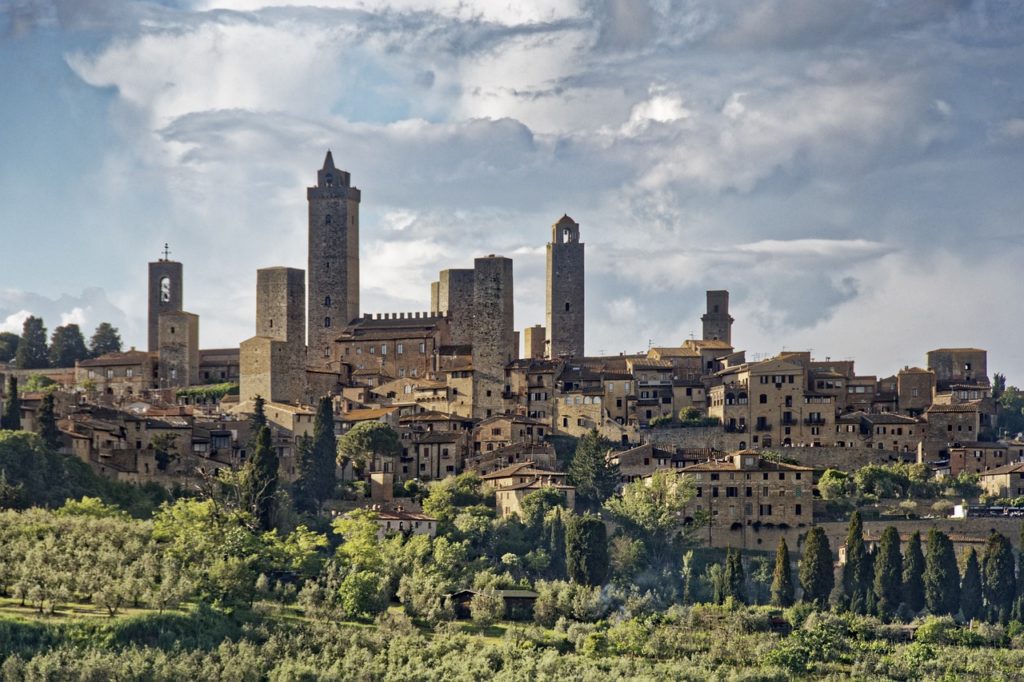
Cinque Terre: beach day trips from Florence
The one to Cinque Terre is definitely one of the most popular day trips from Florence. The Cinque Terre region is not located in Tuscany, but in Liguria, which is a different Italian region. However, Liguria is quite close to Florence, at least close enough to visit the Cinque Terre with a day trip from Florence.
Cinque Terre means Five Villages, because it is made up of 5 villages located along the coast, one after the other: from south to north, they are Riomaggiore, Manarola, Corniglia, Vernazza, Monterosso al Mare. Five gems made of tiny colorful houses built on rocky cliffs, and embracing a little harbor. The five villages are very close to each other and well connected by local trains that stop in each of them, and connect them to the city of La Spezia. They are also connected by some of the most beautiful hiking paths in the world, like the most famous one, la Via dell’Amore, the way of love.
I don’t recommend to go to Cinque Terre by car, parking is just mission impossible even for Italians, and the restricted traffic zones are a nightmare. You have two alternative options:
- By train – it takes about 2 and a half hours, changing trains twice, in Pisa and in La Spezia. Here you will find all the information about day trips to Cinque Terre from Florence and how to get there by train on your own.
- With an organized tour including transport (like this one with optional hiking). Organized tours often also include a boat ride and the chance to hike the trails around the villages.

Day trip to Pisa
Pisa is a town near the coast of Tuscany, about 90 km (56 miles) away from Florence. I don’t think there is any need to remind you that Pisa is the city of the Leaning Tower, but there is much more besides the tower. The medieval complex of Piazza dei Miracoli (which is where the leaning tower is) is beautiful, and also includes the cathedral, the baptistery and the ancient cemetery. Pisa is a lively and very walkable university town, with a historic center full of interesting museums, characteristic streets, bars and restaurants. If you only want to see the Leaning Tower and Piazza dei Miracoli half a day is enough. If, on the other hand, you also want to discover the rest of the city, plan to spend the whole day there, visiting places like:
- The church of Santa Maria della Spina, a gothic jewel box of white marbles on the banks of the Arno river. It used to be even closer to the river, but at the end of the XIX century it was dismantled and rebuilt in a safer location.
- Art lovers shouldn’t miss the national museum at Palazzo Reale (with artworks by Raffaello and much more) and Palazzo Blu, with permanent collections and temporary exhibits.
- Archaeology enthusiasts will love the Museo delle Navi Antiche, museum of the ancient ships. In 1998, during a construction excavation, more than 30 roman ships were found, sunk in front of the ancient seaport of Pisa.
- Don’t miss Tuttomondo, the mural that Keith Haring painted in 1989 on the back wall of the ancient church of Sant’Antonio Abate.
You can easily reach Pisa both by train and by car (in both cases it takes about an hour and a quarter). Here I explain in detail how to go from Florence to Pisa (and vice versa). If you want to visit Pisa without any stress, book a guided tour including transport. There are several options:
- Pisa afternoon tour from Florence (6 hours, with a licensed tour guide)
- Pisa and Lucca are very close and really pretty. You can visit both with a day trip to Pisa and Lucca from Florence (9 hours, customizable with entrance tickets and guided tours).
- Pisa is on your way to Cinque Terre, so it’s often added as an extra stop during a trip to Cinque Terre, like this Pisa and Cinque Terre day trip by train (with a tour guide)
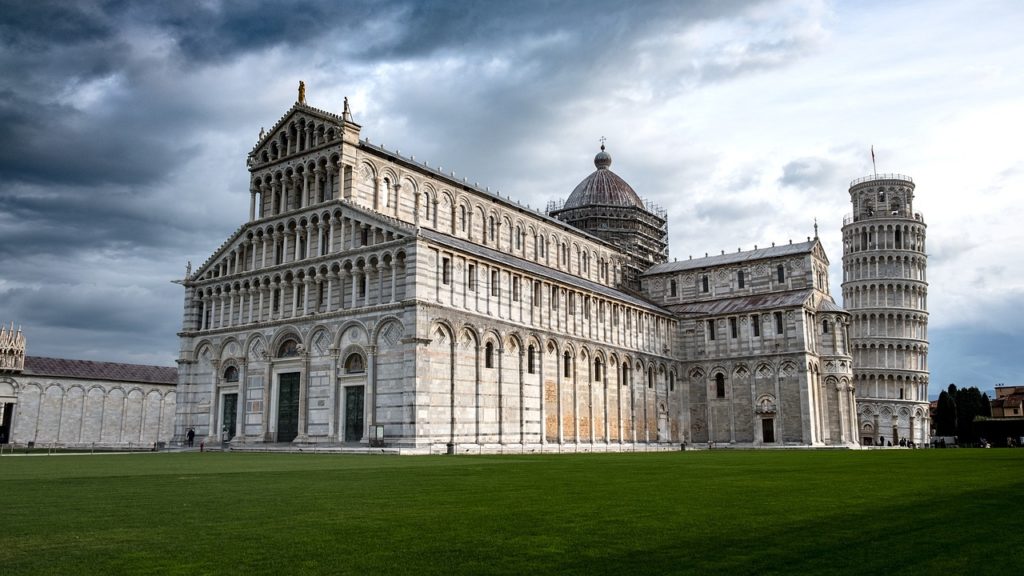
Beach day trip to Pisa
If you want to escape from summer heat and spend a day at the beach, Pisa might not be the best option. The city of Pisa, even if very close to it, is not by the sea. The closest sandy beaches are at Tirrenia and Marina di Pisa, two smaller towns that you can reach by bus from Pisa. There are dozens of beach resorts and some free beaches. It’s very popular among families, especially during weekends. But to be honest is not one of my favorite places for a swim, I prefer the wild, rocky cliffs of Romito, south of Livorno.
There are other options for a beach day trip from Florence, some coastal cities which are well connected to Florence by train (and also with highways).
- Livorno. It’s the cheapest option, it’s a working-class city great local seafood and some urban beaches. Urban beaches are honestly nothing special, but there’s the stunning rocky coast of Romito with clear waters to dive in, just outside of town, going south. There’s at least one direct train every hour from Livorno to Florence and vice versa, it takes 1 hour and 15 minutes. Then there are local buses to go from the station to the beaches (included to Romito cliff).
- Viareggio. A resort town on the beach with plenty of beach resorts and some good nightlife in summer. It’s easy to get there, there are direct trains from and to Florence almost every hour (the journey lasts one hour and a half).
Lucca
Lucca is an ancient city, still today surrounded by its medieval walls, rich in history and monuments. It is famous for its ancient towers, such as the Guinigi Tower (that you can climb), on top of which there are oak trees! The medieval walls have now become a beautiful public park: one of the experiences not to be missed is a walk along the walls of Lucca to see the city from above. And don’t miss its beautiful main piazza, Pizza dell’Anfiteatro, built on the ruins of an ancient roman amphitheatre.
My favorite place is probably the Villa Reale di Marlia, a magnificent villa that once belonged to Elisa Bonaparte, Napoleon’s sister. You can visit the lavish interiors of the Neo-classical villa, but I love the wonderful baroque gardens, with a camellia avenue, an Italian garden, a Spanish garden, a citrus garden, a pond and a green theater made of plants. It’s such a stunning place, that even if it’s located outside of town, it’s totally worth it. You can get there from Lucca station with a 30 minutes bus ride on bus n. 59 (it doesn’t run on Sundays). Villa Reale di Marlia is only open from April to October.
Lucca is also famous for its antiques market which takes place every third weekend of the month in the narrow streets of the historic centre. But the biggest event of the year is at the beginning of November, when Lucca becomes the European capital of comics, cosplay and collecting, hosting the Lucca Comics event, which attracts fans from all over the world. If you’re not a manga/anime/cosplay fan avoid the two weeks in between October and November! Not just Lucca, but the whole area sells out several months in advance, prices skyrocket and everything becomes a colorful, joyful mess.
You can reach Lucca from Florence both by car (but parking in Lucca is very hard, and paid parking is expensive) and by train. By train it takes from one hour and 20 to one hour and 45 minutes, depending on how many intermediate stops the train makes. You can find here on my blog more information about how to get from Florence to Lucca on your own.
Pisa and Lucca are very close and well connected to each other, both by road and by train. For this reason it’s easy to visit both towns in a single day trip. And organized tours often include both places.
- Day trip to Pisa and Lucca from Florence (with transportation)
- Walking tour of Lucca and the walls
- Lucca bike tour with food and wine
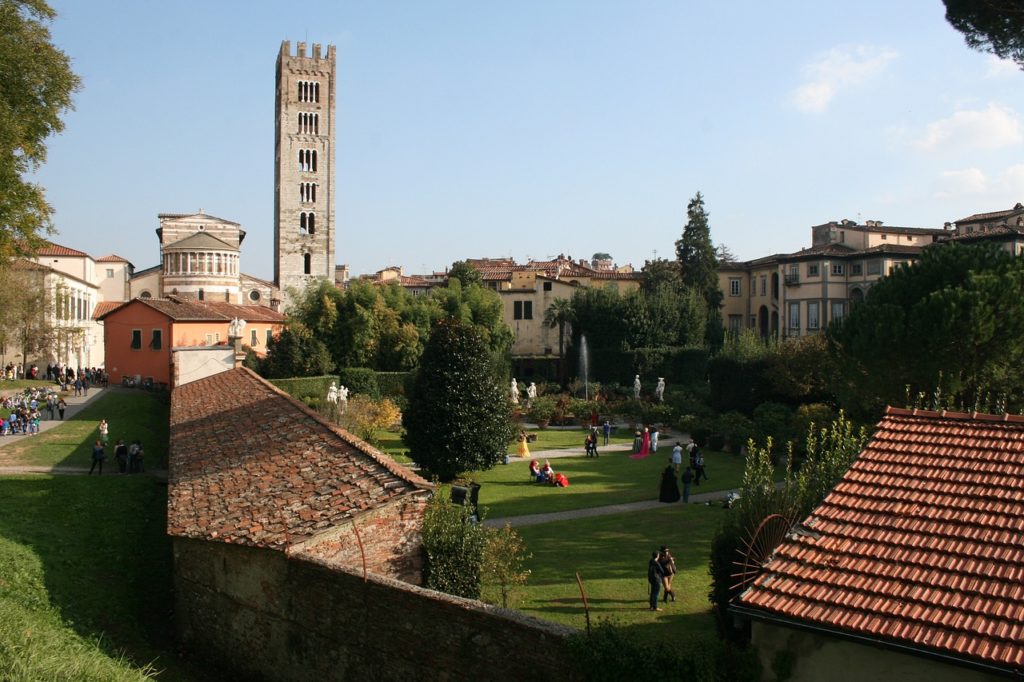
Best day trip by train from Florence: Arezzo
Personally I love Arezzo, in my opinion it is one of the most beautiful cities in Tuscany, so rich in art and history. And at the same time it is one of the least known by mass tourism. Starting from its stunning Piazza Grande, dating back to the 1200s, you can spend an entire day walking the medieval streets and alleyways, indulging in restaurants, cafes, and small craft shops. Don’t forget to visit its churches, especially those that house the Renaissance masterpieces of Piero della Francesca: the Duomo and the church of Santa Maria della Pieve. If you’re into archaeology (but even if you’re not!) don’t miss the ruins of the roman amphitheatre: they are in the middle of a public park, very close to the train station. During summer is still used for outdoor events and shows. There is also an important archaeological museum next to it, the Museo Gaio Clinio Mecenate, with findings from the roman and etruscan civilizations.
An important antiques market is also held in Arezzo, every first Sunday of the month and the previous Saturday. And they also have a traditional Christmas market which is one of the most famous ones in Italy.
You can reach Arezzo by train in about an hour with the direct regional trains (an hour and a half with the regional ones that make more intermediate stops). The city is very walkable and you won’t need to use public transport to get around.
- Check this private walking tour of Arezzo with a local guide
- Small group street food tour in Arezzo
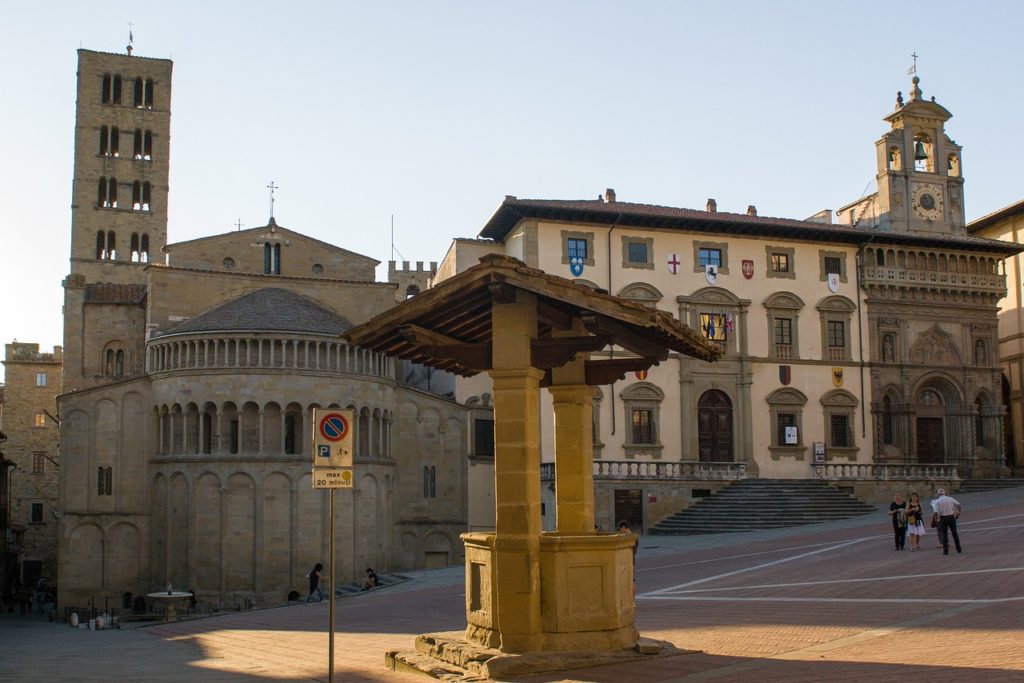
Cortona
Cortona is a postcard picture of a Tuscan village surrounded by rolling hills. It was made famous by the novel Under the Tuscan Sun by Frances Mayes, but those who discover Cortona for the novel, are not disappointed once they arrive here. The places you shouldn’t miss in Cortona in my opinion are:
- The Etruscan Museum. I love the history and archaeology of the Etruscan civilization, and this is one of the most important museums with lots of finds. It’s also housed in the beautiful 13th century Palazzo Casali.
- Eremo Le Celle. A medieval hermitage and monastery, where friars are still living today. It’s an oasis of peace in the silence of the forest, surrounded by rocks, streams and green plants. You can get there with a short walk from the center of Cortona.
- Chiesa di San Niccolò. A very simple Renaissance church, which houses some paintings by one of my favorite artists, Luca Signorelli.
- Santuario di Santa Margherita. The largest church in Cortona, completely rebuilt in the 19th century (the only original part from 1300 is the rose window). Inside there’s the mummified body of Santa Margherita, above the high altar.
- To enjoy a beautiful view of the village and the surrounding countryside, reach the fortress Fortezza del Girifalco, at the highest point of Cortona.
- The stone walls of Cortona, initially built by the Etruscans, then completed by the Romans, and modified several times in the medieval era.
The best way to reach Cortona is with a rental car. Unfortunately it does not have a train station and bus connections are unreliable and a great waste of time. However, there is a station very close, although not too busy, that is quite close to Cortona: it’s Camucia – Cortona, and there are direct trains going there from Firenze Campo di Marte, a suburban station of Florence. From Camucia – Cortona you’ll have to take a bus or a taxi.
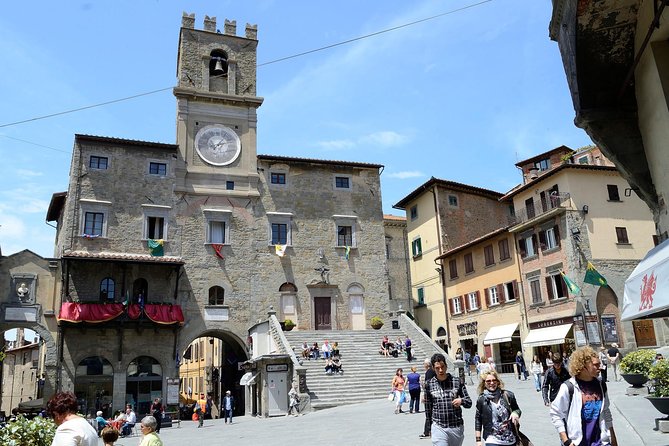
Volterra
Volterra is a wonderful medieval village, still surrounded by stone walls, with a much longer past. It was once an important Etruscan city-state, specialized in the excavation of alabaster, a white stone that when turned into thin slabs is almost transparent, and in the production of delicate and precious objects made from this material. This past is still alive today: the medieval city walls are built on the basis of the much older Etruscan ones, and thousands of finds are on display at the Etruscan Museum Mario Guarnacci. There is also an archaeological area with two Etruscan temples and the remains of a Roman amphitheater, inside a park with large trees.
The alabaster tradition is also still alive in Volterra: in the streets and alleys of the town you will find many small shops selling alabaster objects of all kinds, of ethereal and delicate beauty. I recommend you enter Volterra through the gate in the walls called Porta di Docciola: a long staircase will take you to the town, meeting an ancient public fountain and medieval towers along your way. Near Porta San Felice there is an archaeological excavation that shows the remains of ancient Roman baths.
Every year in mid-August, Volterra takes a leap back in time and returns back to the year 1398 for a week. It is Volterra A.D. 1398, the largest and most important medieval festival in Italy, which attracts enthusiasts from all over Europe. Archery competitions, battles between knights in armor, blacksmiths at work in the streets, and much more.
Fun Fact: Volterra is a location of the popular Twilight saga: this is where, according to author Stephanie Meyer, the members of the Volturi clan live! In the films, however, the scenes set in Volterra were actually filmed in Montepulciano (see the paragraph below on Val d’Orcia).
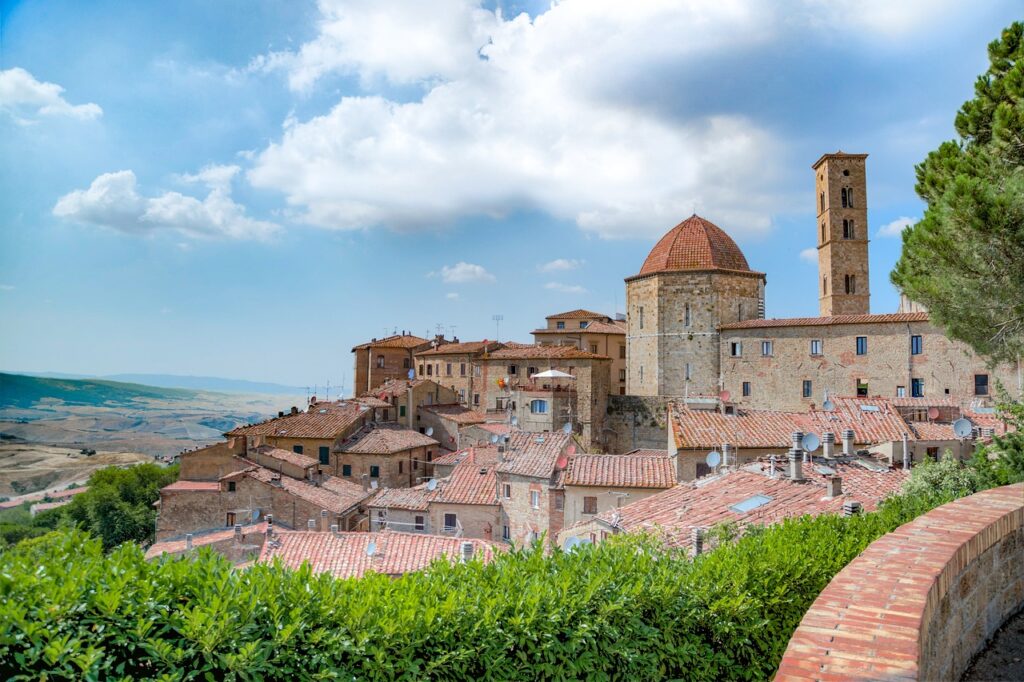
Day trip to Valdorcia (Montalcino, Pienza and Montepulciano)
Valdorcia is a lovely valley in the Tuscan countryside, south of Siena. It’s an area famous for its charming and ancient villages, and for the typical local products: wine, pecorino cheese and extra virgin olive oil, one of the best in Italy. The most famous villages are:
- Montalcino – a medieval village surrounded by walls and dominated by an ancient fortress. It is known for its wine, the famous Brunello di Montalcino.
- Pienza – a small medieval village transformed in the Renaissance by an ambitious pope who was born right here. This wonderful village is a UNESCO World Heritage Site.
- Montepulciano – surrounded by some beautiful rolling hills, this town is famous for its Vino Nobile di Montepulciano wine, and for its underground cellars carved in the stone, underneath wonderful Renaissance palaces.
- Bagno Vignoni, with its stunning 16th century thermal pool in the heart of the village, and natural hot springs.
The villages of Valdorcia are scattered in the countryside, and cannot be reached by train. The best option to tour that area is definitely a rental car. It’s also the best way to enjoy the wonderful landscapes, while driving on small, scenic country roads. I have wrote a post about the best villages and places to see in Val d’Orcia where you can find tons of extra info to organize your own trip there. Or you can take an organized day trip to Valdorcia with wine and cheese tasting, including transportation to and from Florence.
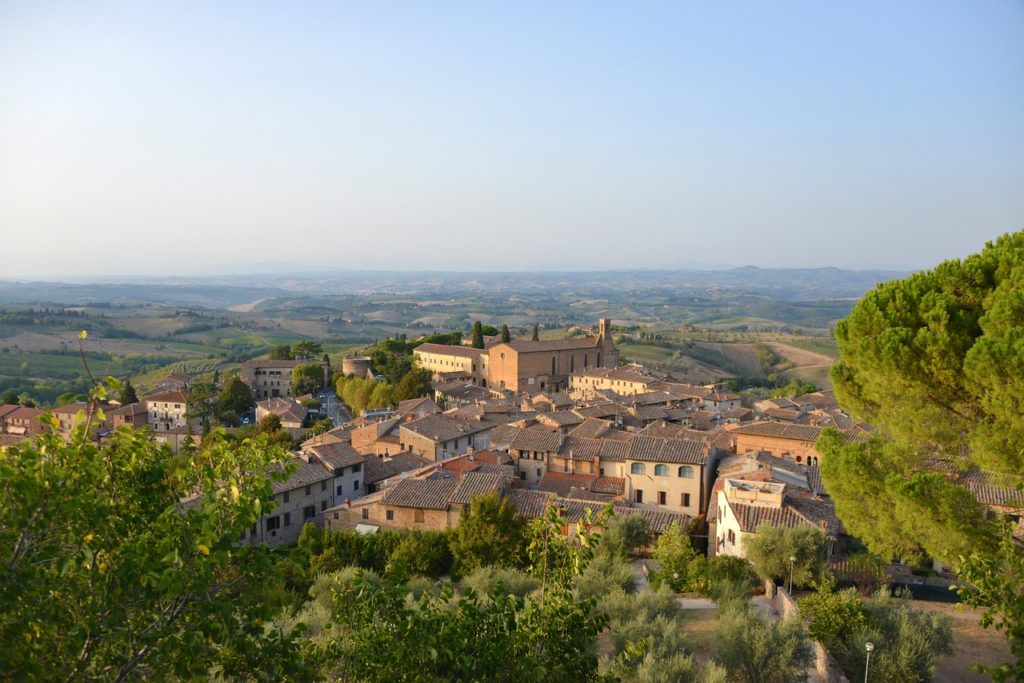
Day trip to Bologna from Florence
Bologna is a fantastic city, rich in art and history. It is one of the cultural capitals of Italy, and is also a very lively university city. But Bologna is also and above all a gastronomic capital, whose culinary tradition has produced some staples of Italian cuisine. Especially the fresh pasta, and especially the lasagna, one of my favorite food in the world! Bologna is the capital of Emilia Romagna, home of balsamic vinegar, prosciutto and Parmigiano Reggiano cheese. Between one meal and another, don’t forget to visit its ancient towers, churches full of artworks and its unique museums. Some of my favorite places in Bologna are:
- The beautiful Piazza Maggiore, with the three most important buildings of the city: the cathedral Basilica di San Petronio (a masterpiece of Italian gothic architecture), the Palazzo Comunale, and the oldest one, Palazzo del Podestà. Also check the nearby piazza del Nettuno, with the famous fountain of Neptune by sculptor Giambologna.
- The Basilica di Santo Stefano, also known as the basilica of the seven churches, because it’s made by the addition of many different buildings one above the other, through over 2000 years of history.
- Museo di Palazzo Poggi and the Anatomical Museum Luigi Cattaneo. Two gems for whoever loves history of medicine, human anatomy, cabinets of curiosities and bizarre things.
- Church of Corpus Domini, also known as Chiesa della Santa (church of the Saint), because there is the mummified body of St. Catherine de’ Vigri.
- Pinacoteca Nazionale di Bologna, the national museum of paintings, with masterpieces by Raffaello, Giotto, Tiziano and Guido Reni.
- Please, don’t forget the lasagne. My favorite spot for a take away lasagna is Pasta Fresca Naldi.
If you want to visit Bologna, plan at least a whole day, but if you have more time available, I recommend spending at least two days there. Definitely one of the best day trips from Florence that you can take, in my opinion! Bologna is easily reachable from Florence in about half an hour with high-speed trains. There are two high-speed train companies in Italy, both are valid and reliable:
- Italo – Italo trains are always high speed.
- Trenitalia – this company has both high-speed trains (called Frecce) and regional trains. I advise you not to go to Bologna with regionals, the journey is very long and there are some changes to make. Select “frecce” when searching.
Most popular activities to do in Bologna:
There is really no reason to book an organized day trip from Florence to Bologna. Instead book your train, go there on your own, and then book a short guided tour for when you’ll be there… Maybe a food tour!
- Bologna walking food tour
- Bologna food experience: factory visits, with lunch and wine tasting
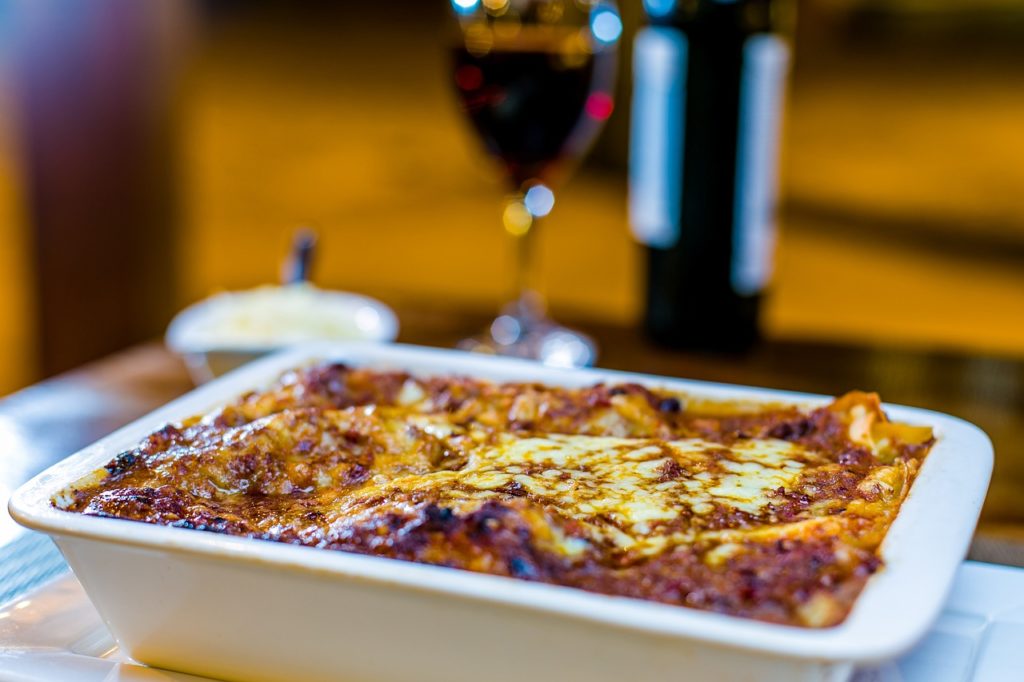
Parma
Even though they are a bit too far for my standards, many people decide to do a day trip from Florence to Modena and Parma. And I can understand why: they are two of the most beautiful cities in Italy, with lots of ancient buildings, museums packed with artwork, a great food culture and still not too touristy. The two cities are close to each other, about 60 km (half an hour by train). So with a bit of organization you can visit them together in a single day, even if very quickly. They are located northwest of Bologna, in the Emilia Romagna region. And they are well connected to Bologna by highways and trains, so it is very easy to get there from Florence, either way. As for trains, you will still have to change trains once, at Bologna Centrale station. Again, you can book on the Italo Treno and Trenitalia websites that I indicated in the paragraph on Bologna.
Parma has a wonderful historic center, with one of the most beautiful Romanesque cathedral and Baptistery in Italy, and one of my favorite museums is Palazzo della Pilotta. But the reason why most people visit Parma is because it’s one of the Italian capitals of food: it’s the cradle of the national pride cheese Parmigiano Reggiano, of the world famous Prosciutto Crudo di Parma and many other yummy things. You can take a food tour around the city, or wander on your own to discover bars, restaurants and street food.
Modena
Modena is famous for its production of traditional balsamic vinegar: one of the experiences I recommend you do is a visit to a traditional vinegar factory, called acetaia, where you can learn how this extraordinary condiment is produced, and how it is aged and reduced (and why it is so expensive!). And don’t forget to have an aperitivo with a glass of wine paired with tigelle (a kind of flat small bread) and gnocco fritto (fried bread dough), both filled with local prosciutto, salami and creamy cheese. Also in Modena you can visit a magnificent medieval cathedral, and palaces packed with artworks from the past.
This area is also the birthplace of some of the most famous Italian luxury cars: Ferrari and Lamborghini. There is a museum for both, celebrating those fast dreams in their hometowns: Ferrari Museum is in Maranello (close to Modena), with the entrance ticket you can also drive your car in the Ferrari racetrack! And Lamborghini Automobile Museum is in the small village of Sant’Agata Bolognese, between Bologna and Modena.
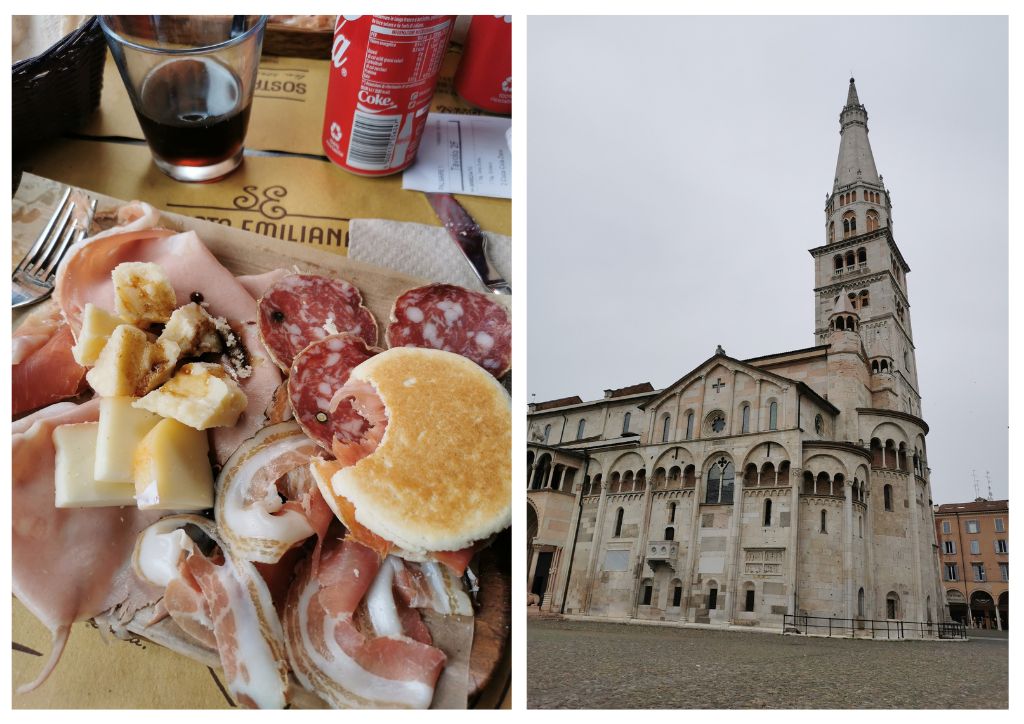
Assisi
There are two main reasons why people visit Assisi: art and faith. Assisi is the city of Saint Francis, who even today, 800 years after his death, remains one of the most venerated saints in Italy. The Basilica dedicated to the saint is a masterpiece of Gothic architecture… well, there are actually two basilicas one above the other: the upper one and the lower one. But the real masterpieces of the Basilica are Giotto’s frescoes showing episodes from the life of Saint Francis (and there are other magnificent frescoes by Pietro Lorenzetti and Simone Martini).
But there is much more to see in Assisi: the church of Santa Maria Sopra Minerva is a unique and wonderful building. In Italian it means Saint Mary Above Minerva, because it’s literally an ancient Roman temple dedicated to Minerva, which in the 16th century was turned into a church. It’s in the Piazza del Comune, the main square of Assisi with the fountain of the three lions and the medieval buildings Palazzo del Capitano del Popolo and Palazzo dei Priori (the town hall).
Other places related to Saint Francis near Assisi:
- Basilica of Santa Chiara. Built in the 13th century and dedicated to the young founder of the female order of Franciscan nuns.
- La Porziuncola, the small church where Francis received the stigmata. It is located about 4 km from the center, in the hamlet of Santa Maria degli Angeli.
- Eremo delle Carceri. Here Francis retreated to pray in isolation with his brothers, surrounded by a thick forest.
Getting to Assisi by train is doable although a little complicated: you have to take two regional trains: one from Florence to the Terontola/Cortona station, and from there take another train to Assisi. The Assisi station is on the plain, while the town is on the hill, about 3 km away. There is a bus, line C, that leaves every 30 minutes, connecting the station with the historic center (or you can take a taxi).
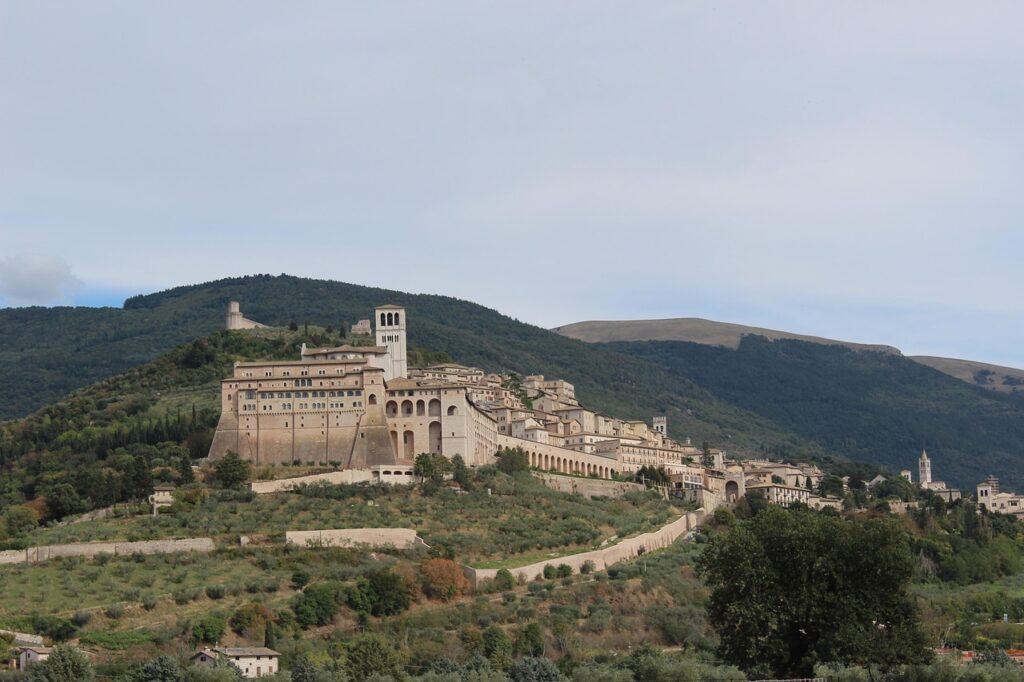
From Florence to Venice or Rome day trip
Many travelers ask me if it is worth taking a day trip from Florence to Rome or Venice. I understand that you want to try to visit as many places as possible in the time available, but I think that is not a good idea. First of all because Venice and Rome are quite far from Florence: it takes at least an hour and a half by train to go to Rome, and two and a quarter hours to reach Venice. By car or bus it takes even longer. You would spend at least half your time on transport.
And then because Venice and Rome are two cities so rich in things and places to see, that a few hours are not really enough. Rome is also huge in size, so moving around requires lots of time. I recommend planning at least 2 days for each of these cities (but 3 days would be better). If you don’t have enough time to visit all those cities, you can always return to Italy for your next trip!
If you are planning to visit Venice too, my blogpost about how to get from Florence to Venice (and vice versa) might be what you need. Instead, if you’re heading to the capital, read how to get from Florence to Rome by train.
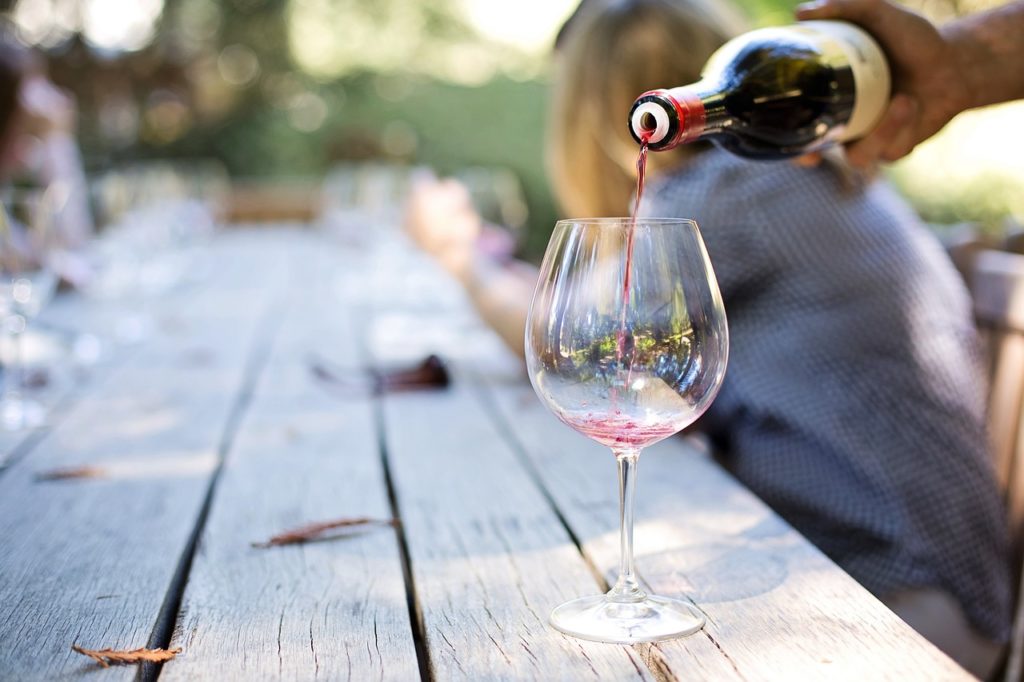
Map of the best day trips from Florence
I have pointed on a map all the places I’ve mentioned in this post, so you can have an idea of distances and locations.
That’s all for this time! I hope I have been helpful in choosing which day trips from Florence to do and which other places to visit in Italy. If you have other tips to add to mine, leave me a comment and share your experience with other travellers!